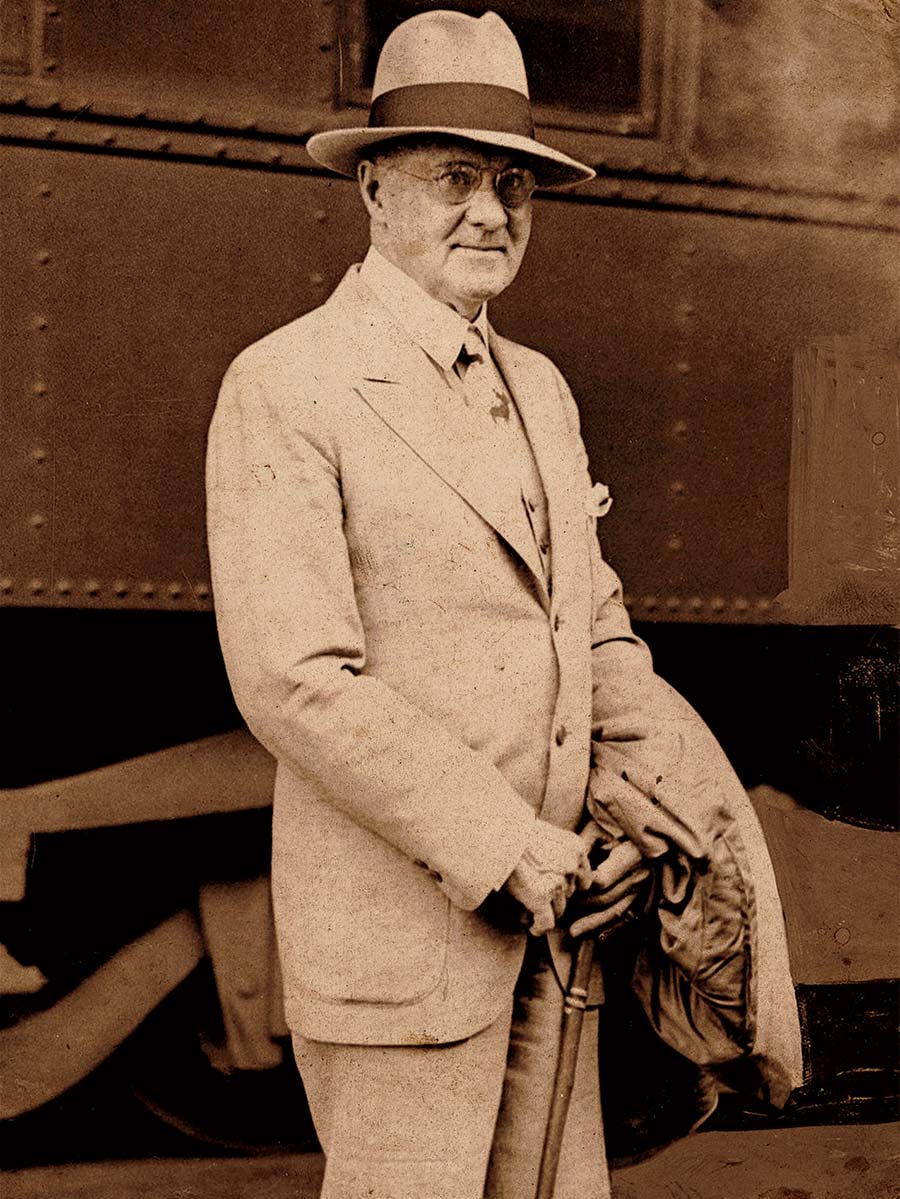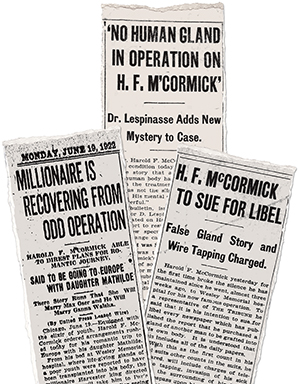
In June 1922, the fantastically wealthy Chicago industrialist Harold McCormick was hospitalized, and the press had a ball figuring out why.
Harold was a son of Cyrus McCormick, whose development of the mechanical reaper in the mid-1800s revolutionized farming and created one of the nation’s largest family fortunes. A top executive at International Harvester, Harold was recently divorced from Edith, who hailed from another super-rich family, the Rockefellers, and news reports connected him first to one opera singer, Mary Garden, and then another, Ganna Walska.
On June 12, when the 50-year-old McCormick checked in at Wesley Memorial Hospital, at 25th and Dearborn, he took over an entire wing of the sixth floor and guards were posted at every door. But what really made reporters for the Chicago Daily Tribune and other papers prick up their ears was the name of the attending physician: Victor Darwin Lespinasse.
Since 1911, Lespinasse had been developing a surgical technique for testicular transplants. He’d notched his first purported success by implanting a donor’s testicle into an impotent 38-year-old who had lost both of his — one in an accident, another in a botched hernia operation. Four days after the surgery, Lespinasse reported in 1913, the patient had “a strong erection accompanied by marked sexual desire” that was so intense he insisted on checking out of the hospital right away so he could go satisfy it. In 1914, Lespinasse operated on another impotent 38-year-old. This one had both of his testicles, but they were “a trifle small and much softer than normal,” according to Lespinasse’s account. After the surgeon gave the man a supplemental testicle, he got erections every day for a month, Lespinasse reported. The New York Times had dubbed Lespinasse the dean of gland transplants and quoted him as saying that “a man is as old as his glands.”

Knowing all this, the Chicago press quickly guessed why Harold McCormick was in the hospital: He must be getting new testicles to invigorate his sex life with 34-year-old Walska, his latest love. Reporters tossed pebbles at the windows of Lespinasse’s home late at night, wiretapped a phone call between the surgeon and his patient, intercepted a telegram that McCormick sent to Walska in Europe, and importuned nurses and orderlies for details. Going on leaks from hospital employees, the press reported that during the operation, the live donor of the testicles and the recipient were behind separate sets of drapes, with separate medical teams, and only one doctor and one nurse were allowed to move between the areas. From his hospital bed, McCormick denied that he’d received a testicular transplant. He threatened to sue the papers for libel.
Finally, on June 23, Lespinasse announced, somewhat cryptically, that McCormick had undergone surgery designed to revitalize wasted tissue, and that the patient was feeling well. Lespinasse did not deny press reports that the operation had cost McCormick $50,000 (the equivalent of about $750,000 today). But he did deny transplanting human testicles into McCormick’s scrotum. “The story that any part of any other human body has been or will be used in the treatment of Mr. McCormick has not the slightest foundation in fact,” Lespinasse said.
So the press moved on to the next logical explanation: McCormick had received not another man’s testicles, but a monkey’s. This wasn’t that big a stretch. The New York Times had reported that Lespinasse’s technique “often includes the grafting of the glands from a younger man or from a goat or monkey.” And in France, Serge Voronoff, a Russian-born physician, was at the time getting attention from the medical world for his practice of transplanting monkey glands into men. As early as the late 1880s, Voronoff had begun exploring medicine’s potential to slow down aging by inserting bits of the ground-up testicles of guinea pigs and dogs under his own skin. By the early 1920s, Voronoff’s experiments had gained a measure of credence among medical professionals.
Indeed, around the time McCormick went under the knife, male glandular transplants were becoming something of a fad. In Chicago, Max Thorek, founder of both Thorek Memorial Hospital and the International College of Surgeons, wrote a medical reference book, long since out of print, about testicles; nearly a quarter of it concerns testicular transplants. “Although Thorek continuously takes a stance supporting the ability for testicular transplantations to cure a plethora of ailments,” Monica Stokes of the International Museum of Surgical Science wrote in 2017, “the true importance of these procedures seems to lay in an extension of sexual prowess.”
This line of medical reasoning had a frightful side. Frank Lydston, a University of Illinois physician who in 1914 transplanted the testicle of a recently deceased man into his own scrotum — ostensibly to determine whether such implants could be a solution for dementia, impotence, sterility, chronic diseases of the skin, hardening of the arteries, and other problems — advocated castrating black men who committed sexual crimes. “A few emasculated negroes scattered around through the thickly settled negro communities of the South would really prove the conservation of energy, as far as the repression of sexual crimes are concerned,” Lydston wrote in a chilling article titled “Sexual Crimes Among the Southern Negroes.”
There’s no evidence suggesting that Lydston integrated his appalling racial theories into his medical practice, and in any case testicular transplants as an age-reversing technique would soon fade into obsolescence. As John Nanninga, a retired physician in Winnetka, writes in his 2017 book The Gland Illusion: Early Attempts at Rejuvenation Through Male Hormone Therapy, multiple experts in the field ultimately concluded that much of the effect of a transplant was as a placebo: For recipients, the very thought that they could become young stallions again was enough to rekindle their sex drive. Nanninga implies that doctors like Lespinasse and Voronoff may have suspected this all along. “When patients noted decreasing memory, loss of vigor, and sexual lassitude at some point after the transplant,” Nanninga writes, “Voronoff encouraged them to have a repeat procedure. Those who were credulous enough and wealthy enough to afford his operation did so.”
Whatever the medical value of such transplants, the members of the press covering McCormick’s surgery seemed happy enough to play along. When the industrialist delivered himself to Paris two months after his operation to marry Walska, who had been installed in a chateau in the French countryside, he was described by one reporter as “a younger, gayer, more youthful, apparently indeed rejuvenated Harold McCormick.”
The marriage ended in 1931. Twelve years later, after McCormick’s death, Walska published an autobiography titled Always Room at the Top. In it, she offered Lespinasse and his contemporaries what amounted to a backhanded endorsement: She wrote that while she’d hoped she and her husband could share a “divine companionship of the spiritual love,” after his surgery McCormick became “insatiable in his search for the realization of the physical.”


